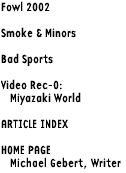


Me, I couldn’t be happier about it. Not that I’m particularly in favor of teen smoking. But the “I Decide” campaign was created by teens themselves. And so, as someone whose advertising earnings pay all kinds of Illinois taxes, I really appreciated my state throwing its official weight behind the widespread notion that only young people can create advertising that appeals to youth (or “gets down with them,” as I believe the kids say today).
Lower the entry point to the business below 18, and inevitably the official age of creative senility will fall too, from 40 to 30 to 21. By the time you’re old enough to drink beer, you’ll be too old to be hip enough to work on it. Then what—will agencies try to recruit really hot 9-year-olds to freshen up their fruit roll-ups reels? Will Omnicom buy 10% stakes in pre-schools?
It’s worth remembering what one Chicago copywriter did when he hit that too-old-to-relate-to-youth age. John Hughes went to Hollywood—and promptly wrote two of the most popular teen movies ever made, Sixteen Candles and The Breakfast Club. Part of what made kids respond to them over so many other 80s teen comedies was that they didn’t just have a teenager’s hormonal tunnelvision—there was also an adult’s perspective (not to mention articulateness) about what it is to be young that was missing from, say, Tubetop High.
As for details like making sure the movies were up to date on the latest, hippest teen slang, Hughes didn’t even bother—he just made his own up. Now there’s an idea—pop culture like movies and advertising could create youth trends, not just echo them.
Yet if ability and age are only dimly related at best, there is one thing that tends to come with experience, and that’s experience— as the original outdoor in the “I Decide” campaign proved. There’s a body of knowledge about how to do outdoor well, and even good print agencies often blow it, creating elaborate print ads when what you really need is one pithy step above subliminal advertising. But the “I Decide” outdoor not only had too much copy—it had a too-complex concept, a too-messy visual, a too-hard-to-read logo, and two too many calls to action.
In short, it made all the mistakes you’d expect...from people who haven’t been working long enough to have already learned from those mistakes. Advertising. It’s an adult decision.